Updated July 2023
The human brain is incredibly intricate. Where to even begin? It doesn’t just get you through daily tasks and conversations. It creates emotions like love, fear, anger, and passion. The human brain has so many decisions to process, and it wants to process them as quickly as possible, which is why it has mechanisms to swiftly make decisions—shortcuts, if you will.
The beginning of the pandemic has set a new norm for businesses, leading them to concentrate their efforts on the online landscape and to strengthen their digital presence.
And the reason why this marketing model has gone through such an important development is not only the Covid-19 situation, but also the use of psychological principles in eCommerce to attract customers and drive conversions.
These are psychological triggers that your business can use to drive desired actions (i.e., conversions) among your target market.
This is great news, isn’t it?!
We drummed up 24 psychological triggers to help you sell more products online at a time when everyone is competing for attention.
#1. Offer something for free
Who doesn’t love free things?
If you were presented with similar products that gave the same results, and one was cheap enough and the other offered a 30-day free trial, which one do you think you would choose? Get Response, the all-in-one marketing platform, is a great example of the lure of offering a free trial. And even better, they don’t require a credit card!

GetResponse offers a 30-day free trial (no other obligations entailed)
Bonus: Learn how to bring more sales with these 6 SaaS email marketing tactics .
Offering something for free is the type of stimulus that can make the unknown seem less scary. It effectively lowers the mental and physical barriers to trying something new. You don’t have to whip out your credit card, think about canceling something if you don’t like it, or think about the potential of wasting money.
#2. Use novelty
People are willing to pay for new and improved versions. In fact, it’s more than willingness—they want to. The neurotransmitter dopamine is released in our brain when we try new things, which gives us a feeling of pleasure. That’s why people love upgrades, improvements, new features, and new innovations. You don’t have to add a new product to your offering to use novelty as a psychological trigger to help you sell more; just add a new feature or alter the way something works (just don’t forget to tell your customers about it!).
Wondershare did just this. They didn’t create something altogether new; they just updated their product Filmora. Updates encourage people to try the latest version of a product they are already happy with, and encourage people who didn’t like previous versions to come back.
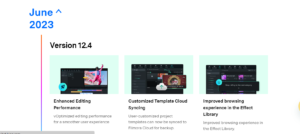
Wondershare continuously updates its product, Filmora 12.4, with new features and tools
#3. Leverage customer reviews
Customer reviews communicate that the customer looking at your marketing content isn’t the only one who is interested in it; someone else has used it and seen great success!
93% of customers read online reviews before buying a product and around 49% of consumers say they trust online reviews as much as personal recommendations. Therefore, it’s safe to say customers are getting smarter and smarter with their purchases and hierarchize others’ buying experience evaluations.
You can showcase customer feedback pretty much everywhere: on your website, on social media profiles, or even use them in email campaigns or datasheets. Possibilities are endless in leveraging positive feedback to increase trust in your brand or product(s). The psychological outcome of this is that prospects seeing people sharing positive experiences are more inclined to buy from you than those who don’t read them at all. Also, customers seeing those reviews might want to leave a review as well, helping you increase your ratings.
Coupa used customer reviews to sell more by featuring handwritten customer success stories with real pictures. Coupa is a great example of making reviews personal to help potential customers connect better with their product.
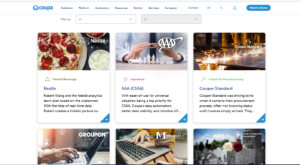
Coupa’s customer reviews
#4. Add a “most popular” pricing option
It’s quite reasonable to suggest a pricing option to a visitor because, after all, when they can’t decide, they won’t buy. This doesn’t mean that you need to recommend the base-level package. Prompt them to purchase the middle or largest package. There’s a fine balance between not pushing past their limits but encouraging them to step it up a bit.
Used wisely, colors can guide visitors towards taking the desired actions on your website. For example, use red to create a sense of urgency. PCloudy, the mobile app testing platform, is a great example of using a color and centering the “most popular” price plan to catch the visitors’ attention and direct them to the package they want prospects to purchase.
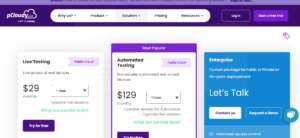
PCloudy uses purple to attract visitor’s attention to the package they want
#5. Use curiosity
People are so inherently curious that once they have just a bit of information that piques their interest enough, they can’t help but want more. So, give them an itch that they must scratch; start a story, but don’t finish it. Let their curiosity get the best of them so they find themselves moving in the direction you want them to go— a sale.
Discovering the product on their own is a powerful experience for customers because unveiling the mystery by doing it themselves has a more long-lasting effect on the mind.
That’s why free trials are a good way to get your foot in the door. You’re confident enough to provide the user with the support needed, but ultimately the product will do all the talking.
#6. Add a sense of urgency/scarcity
People love being the first ones or the only ones to get something. We selfishly, and subconsciously, love one-upping our peers. So, if you can position something in a way that implies that only a limited number of people will have access to it, you will sell more. Limited time offers raise that sense of urgency. They, along with discounts and free shipping, will boost sales immediately.
Buildbox creates a sense of urgency with their discounts that works well. Showcasing limited-time deals and the value of extra savings in bundled offers helps to convert anyone who is on the fence or debating between them and one of their competitors.
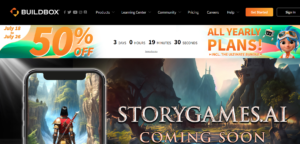
Buildbox’s time-limited summer discounts
#7. Use “sale”
Nothing triggers conversions like a good ol’ sale! By having a sale, you aren’t giving up quite as much as giving away a free trial and get the most out of consumer psychology eCommerce way of selling.
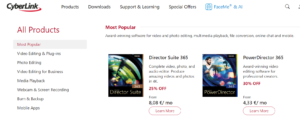
Check out how Cyberlink advertises its July sale
Did you know that people could respond better to $$ off sales versus % off? It just depends on what values you are looking at. Try both ways and see what works best for you! If you have a $$ off sale, you can optimize it even more by lowering a $40 product to $39.99, because that makes people think it is $39 instead of $40.
#8. Use strong visuals to create emotions
The images you use are so important. People know hogwash when they see it so don’t use generic stock images. A strong visual will generate an emotional response in viewers, thus helping people connect to your product or service, and increasing the potential that they’ll remember the site visit.
Choose images that make your customer feel happy because that’s what they want, after all—happiness. A picture of a happy person or customer will hit the spot and help you sell more because you generate happiness.
Brands also use visuals to be able to mirror the customer’s biggest dreams, while also being relatable, so the purchasing process gives them a sense of being closer to a wishful vision.
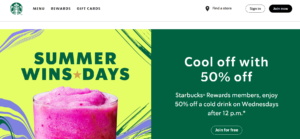
Image source: Starbucks
#9. Find a common enemy
We define enemies to help us make sense of the world and negative outcomes. What is the common enemy that is keeping your customer from getting the results that they want? The “enemy” that your customer has can be anything—a product, a concept, or a company—anything!
Zapier saw that they could unite with their customers against a common enemy: wasting time on tedious tasks. Because of that, now more than three million people rely on Zapier to take care of their tedious tasks. Find common ground with your prospects by relating against a negative outcome.
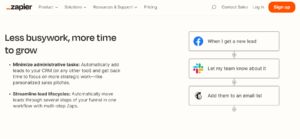
Image source: Zapier
#10. Use influencers
Use people that your audience trusts to sell more. Your customers see the person they trust and think “if this person says it’s good, then surely it is!” These people carry so much power and they can use it by working with you as a speaker, through social media, distributing a code or trial to their following, or sharing a link that leads back to you.
Cartier used actress Lilly Collins to star in the promo video for their Pathere bag. The video, 15 seconds in length, reached an audience of 15 million viewers.
#11. Use storytelling
Stories are a great way to trigger your customers’ brains to help you sell more. Why? Because stories trigger emotions and 95% of our cognition happens within our subconscious—the part of our brain that makes emotional connections. Stories creatively use words, images, and sounds that, if done well, help you stand out amongst all the noisy content. A well-told story helps people feel experiences that they haven’t even lived by activating areas of their brain related to sight, sound, taste, and movement. A good story can increase people’s perception of your credibility. Connect people to your product through a good story.

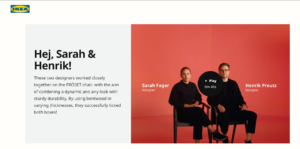
IKEA uses storytelling to guide visitors, in a subtle manner, to the product catalog
#12. Use numbers and statistics to build credibility
Sharing very specific claims makes you seem more believable. Concrete numbers bypass natural skepticism. Some numbers are more convincing than others, though. For example, would you be more likely to believe that someone saved $5,000 using a product or $5,437? Give the real numbers because people will know.
Appcues used numbers to make them appear more credible on their website and sell more. They cited the % adoption increase, the % user retention, and the rate of increased responses their users got in their own businesses.
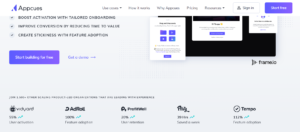
Image source: Appcues
#13. Make your prospects feel valued
According to Maslow’s hierarchy, love and belonging account for some of the basic needs that motivate humans and their choices. We all want to feel valued and significant so we will make choices for the alternatives whose outcome has a better chance of getting people to recognize the value of our individual uniqueness.
The Dollar Shave Club creates a personalized package suggesting exclusivity based on the premise that no two people are the same. They move visitors to their site through a questionnaire to build up the concept that they are creating a customized box design just for them.
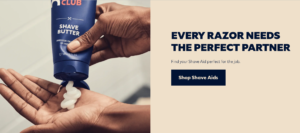
Image source: Dollar Shave Club
#14. Communicate authority
While people will normally follow the crowd, they may follow a single individual or company if they perceive them to be an expert in that domain. You can either promote yourself as that expert to sell more (by naming the different outlets where you appear or have been featured, for example) or feature people or companies that back you to signify your authority. If you have top-notch customers, show their endorsement on your website. If a celebrity backs you, let people know to experience that increase in sales!
If you are backed by relevant social authorities and thought leaders, that must mean that you are a leader in your industry. OptinMonster claimed the #1 one position in the email capturing space because they’ve powered over 1 million sites.
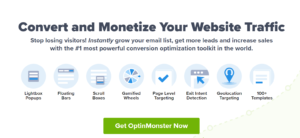
Image source: OptinMonster
#15. Color psychology
Did you know that colors trigger more emotions than words? As such, red is associated with energy and passion, orange is associated with fun, positivity, and good health, yellow with optimism and joy, and blue with confidence and trust. Colors define our moods and have the power to influence our responses because they are part of color psychology eCommerce. Not only that, the brain processes visual information 60,000x faster than text! Color psychology is a great way to help you predict and guide the choices your customers will make so you can sell more.

Estee Lauder uses gold as its main color to reinforce its messaging around confidence
#16. Leverage emotions
Did you know that pain is more powerful than pleasure? Address their pain points to sell more, but not to an extent that it seems fake.
In its copy, AmazonFlex invokes common situations that its target market can relate to, particularly balancing the personal with the professional. By mentioning the multiple ways in which you can earn extra money in a flexible manner, the company creates a scenario that induces hope for the future, therefore motivating visitors to access their offer.

AmazonFlex invokes the pain points of its target market
#17. Sense of belonging
We all have an innate desire for community and a sense of belonging, as Maslow pinpointed so well in his hierarchy of needs. That’s why making your prospects feel like part of a larger group can make them more susceptible to listening to your message.
Hubspot tugged at people’s heart strings by communicating the community that they built. Their claim of their products being “Powerful alone. Better together.” extends to the social angle, as well. They also developed wonderful customer support and communities of users to create that sense of connectivity.
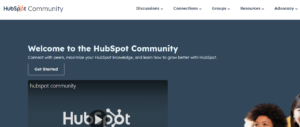
Image source: Hubspot Community
#18. Use reciprocity
People don’t like feeling like they owe someone—so they won’t! If you give them something, they’ll want to give it back to you. Sell more by first providing your potential customers with free tools, resources, samples, or gifts.
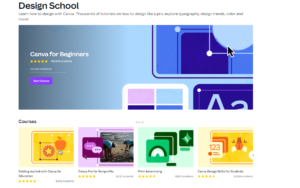
Canva provides free learning resources
#19. Sell benefits, not features
Companies have the tendency to advertise the features that they created for their product. After all, it’s because of those features that people will see results, right? The thing is … features lack emotional connection; they are purely logical.
People care about their own problems and how you can solve them. Selling the benefits is what helps people truly understand how the product would improve their life. By doing this, you play to people’s emotions and inspire happiness.
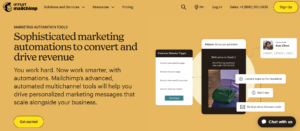
Mailchimp focuses on the benefits that customers get from using its solution
#20. Use the PAS formula: Problem, agitate, solution
This formula is like good storytelling. You start by identifying the problem and then agitate it by bringing up common symptoms that your customers can relate to. Don’t rush straight to the punchline, though. Enough tension must be built up first. If the story is crafted properly, it should be an easy sell and your solution should be an obvious answer. Agitate the problem, then provide a solution—your solution.
#21. Build anticipation
Just like the previews for the next episode at the end of the episode you just watched on Netflix, you can build excitement about your new launch. People need just enough of a cliff hanger to make them excited and keep them coming back for more. In fact, the Zeignarik Effect states that people are more likely to remember when information is incomplete, because the missing portion sticks in their mind. That missing portion just needs to have piqued enough curiosity to keep them thinking about it. To build anticipation, you need to be thinking a few steps ahead in your campaign so you can plan for how you will build it.
Will it be with teasers? Webinars? A countdown? Marketing emails? Good luck triggering the mind to want to come back to learn more and buy more!
#22. Social proof your business
To paraphrase Robert Cialdini, social proof is one of the six key principles of persuasion. When aligned with reciprocity, consistency, authority, liking, and scarcity, it can be used to influence people’s actions.
That is exactly what a brand focuses on when trying to promote themselves.
Social proof has a direct link to popularity and the concept of being liked, and in most cases, this happens on social media. So, as previously discussed, a brand personality constructed through content, influencer marketing, and other digital marketing tools can help you boost conversions and most importantly, gain mental space in your customer’s mind. This is an essential factor in reaching for that eCommerce psychology wisdom.
Bonus: Find out here What is Social Proof & How to Use it for eCommerce.
#23 Loss aversion
From a psychological point of view, the pain we feel from losing something has a much stronger effect on our decision-making process than the satisfaction of receiving something.
This is called the loss aversion factor and is a powerful tool in persuading potential users in purchasing.
To create the feeling of loss for the targeted audience, you can showcase different materials, like tutorials or videos of people using the product and making the language personal. More than that, let the users’ imagination take the wheels and induce them into scenarios where they feel a sense of urgency that if they try or buy your product, they’ll be passing on unmissable offers.
#24 Hop on trend jacking
It is no news that we live in a world where trends are digital-driven and are very much present in our day-to-day lives.
Even though most fads come and go very quickly, they are still a great window of opportunity to sell a product when it’s riding the wave of popularity.
For example, for a few months now we’ve been living in Barbie’s world with the release of the much awaited and promoted Barbie movie. The heavily marketed release has incentivized other brands to borrow the concept and have limited Barbie product lines too.

Image source: Nyx
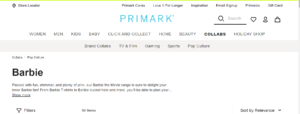
Image source: Primark
Conclusion
Understanding how your customers’ mind works and what setoffs can help you tap into their wants and needs will be key to boost your online sales and make you an important player.
The psychology behind consumerism will give you a head start in playing the eCommerce selling game.
Don’t forget to take a glance at these psychological triggers next time you plan to make a move. After all, your relationships with your clients are the most valuable ones!





